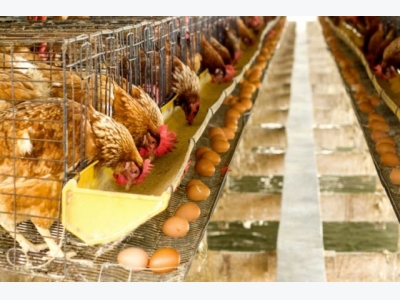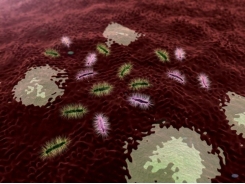Feathers in feed? Not just an idea for the birds

© iStock/eakkachaister
Extrusion and microorganisms may offer a way to generate a low-cost, sustainable protein feed ingredient from waste feathers, say researchers.
A team of researchers from several academic institutions in Brazil examined a potential method for improving chicken feather hydrolysates and evaluated the resulting by-product as a feed ingredient.
The group published its work in the journal LWT – Food Science and Technology.
“We show that keratinolytic B. subtilis AMR is able to degrade chicken feather producing a feather hydrolysate that is rich in low molecular peptides and amino acids,” the researchers said. “The hydrolyzed feather obtained by a microbial process represents a potential alternative for protein enrichment of extrudate food. Finally, a blend of cornmeal, a starch-based food material commonly used in feed, and feather hydrolysate was tested.”
The poultry industry produces approximately 6 million tons of feathers as a by-product annually. The major constituent of feather is protein: 80–90% of which is keratin. In order to use feather protein in animal feedstuffs, it must be hydrolyzed by chemical, physical or enzymatic processes, said the researchers.
The aim of their study, said the team, was to improve the production of chicken feather hydrolysates using keratinolytic Bacillus subtilis AMR and evaluate the effectiveness of a blend of this hydrolysate with cornmeal produced by extrusion.
The addition of sucrose (0.5 g/L) to the feather medium increased the keratinolytic activity of B. subtilis AMR by 1.3 fold. The highest enzymatic activity and production of soluble protein were achieved at pH 8.0.
The fermented feather medium presented large amounts of protein with low molecular weight that provided greater nutrient bioavailability. The physicochemical properties of the extrudates showed that the addition of hydrolyzed feather improved the ash and total N content. All essential amino acids were detected in the corn–feather hydrolysate extrudate.
The team said their work represents the first study that describes the use of microbial feather hydrolysate in a blend with cornmeal to make an extruded product. "These results demonstrated the potential use of this hydrolysate as a supplement in animal feed."
Process
The main component of feathers is keratin, which makes them resistant to enzymatic lysis using common peptidases, said the authors.
A current method to utilize them for use as a feed ingredient invovles steam pressure-cooking and chemicals to make the feathers more digestible – but the process is expensive, damages some essential acids and is considered non-sustainable.
“One approach is to apply biologic and/or enzymatic treatments to degrade feather for the production of feed ingredients,” said the researchers.
Methods and materials
In the study, feathers were washed and an inoculum of B. subtilis AMR was added to 100mL of feathers with 0.1g/L yeast extract, the researchers said. Several trial buffers were also examined, including citric acid buffer, phosphate buffer and aminoacetic acid buffer and the mixture was incubated for eight days.
A set of related test mixtures combined feathers and the phosphate buffer for six days along with an additional substrate source, they said. These had added glucose, sucrose, corn steep liquor, casein, gelatin or yeast extract.
Samples of mixtures in both trials were collected daily for analysis, they said. Microorganisms used were checked for growth, hydrolysate production, feather degradation, keratinolytic activity and soluble protein concentration, they said.
In a third trial, B. subtilis AMR was added to 1L of feather medium and incubated for 6 days to produce microorganism-hydrolyzed feather, they said.
The final portion of the study added the microorganism-hydrolyzed feather to cornmeal using an extrusion process, said the researchers. The mix included 1kg corn meal and 260mL hydrolyzed feather.
A control without hydrolysate was also examined to determine if using the hydrolyzed feather would improve the nutritional value, they said. The blend was generated by a single-screw extruder at temperature zones 50, 100 and 130 C.
Results
For the keratinase activity and feather degradation the optimal pH was found to be 8, resulting in the highest enzymatic activity and the generation of soluble protein, the researchers said.
“The feather solubilization at pH 8.0 after six days of fermentation was 95%, the highest value reached,” they said. “The growth of B. subtilis AMR at pH 7.0 and 9.0 on feather leads to 91% and 35% of degradation of feather, respectively.”
In the second trial, use of an additional substrate was found to boost keratinolytic production of microorganisms and the feather hydrolysate, they said. Of the substrates examined, sucrose at 0.5g/L presented as the best addition to support keratinase production.
Results of by-product analysis found that microbial hydrolyzed feather could offer an additional hydrolysate protein source for use in feed, they said.
Adding the microorganism-hydrolyzed feather to cornmeal improved the ash content, peptides and amino acids, said the researchers. All essential amino acids, save methionine, were found in the corn and feather hydrolysate feed.
Related news
Tools

Phối trộn thức ăn chăn nuôi

Pha dung dịch thủy canh

Định mức cho tôm ăn

Phối trộn phân bón NPK

Xác định tỷ lệ tôm sống

Chuyển đổi đơn vị phân bón

Xác định công suất sục khí

Chuyển đổi đơn vị tôm

Tính diện tích nhà kính

Tính thể tích ao



 Grants to explore poultry yield, heat stress resistance
Grants to explore poultry yield, heat stress resistance  Cytidine and uridine may boost chicken performance, gut…
Cytidine and uridine may boost chicken performance, gut…